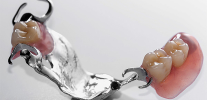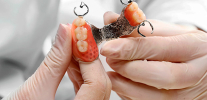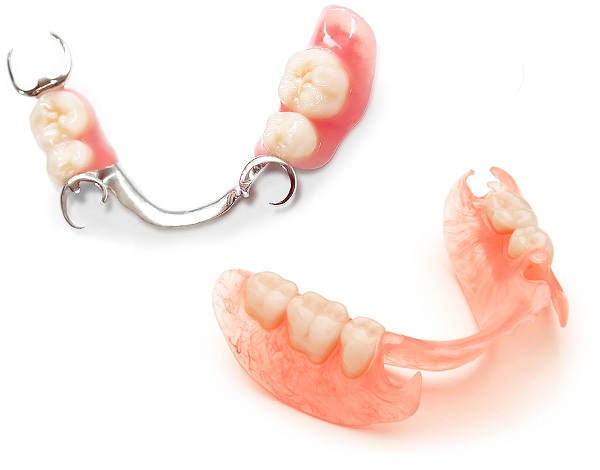
When, for one reason or another, the loss of one or several teeth occurs, a natural question arises - how could they be restored? Moreover, so that it was not very expensive (implantation is not affordable for everyone), and that the denture looks beautiful and does not cause discomfort when talking and chewing food.
In addition, as practice shows, many people fear that a removable denture may simply fall out of the mouth at the most inappropriate moment (for example, during a conversation), or it will be too noticeable to others, associating with the “false jaw”.
All these fears are partly not really unfounded - there are quite a few negative reviews about dentures when the patient could not get used to the removable design, and she was sent “to the far corner of the table”. However, fortunately, there are also partial dentures that are comfortable to wear and have a high level of aesthetics.
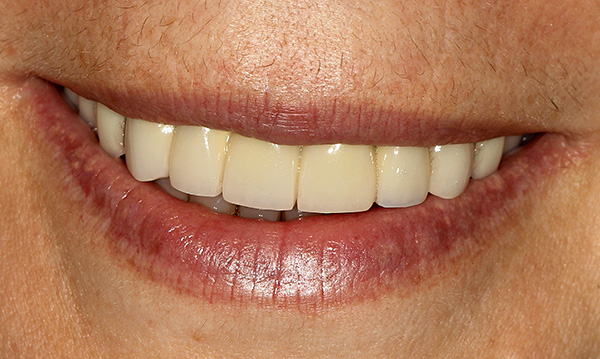
On a note
Partial is called a denture, replacing one or more lost teeth. There are also complete dentures used in the complete absence of teeth on one or two jaws at once.
In general, the situation when there are at least a few teeth remaining in the mouth is much better from the point of view of the upcoming prosthesis than if there were no teeth at all - there are supports for which this or that structure can be fixed. Therefore, it is important not to hurry with the removal of diseased teeth, if there is even the slightest chance to cure them and save them for the future.
Next, we will look at what types of partial dentures exist today, what are the pros and cons of each option, and which of them may be the best choice in a given clinical situation ...
Types of partial dentures
Among removable dentures used in the partial absence of teeth in the oral cavity, the following types of orthopedic occupy a significant niche:
- Acrylic (laminar). Acrylic plate denture got its name due to the fact that the basis of this design is a plate that transfers chewing load on the palate and gums. Such artificial limbs are made of rigid acrylic plastic.There are full and partial acrylic dentures. Partial acrylic prosthesis has special metal hooks (clasps) for fixation by supporting teeth. Removable acrylic prosthesis can be used for almost any degree of tooth loss (especially significant, and it does not matter in which department - terminal, lateral or front);
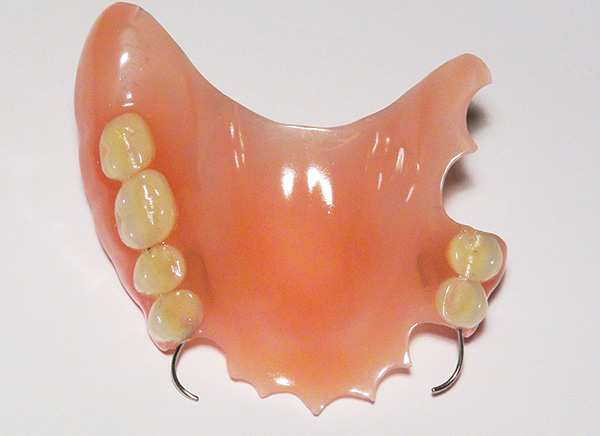
- Nylon - different from acrylic primarily for its elasticity - they are soft. Their advantages and disadvantages result from this property - they are more comfortable to wear, but they hold up worse in the mouth and distribute chewing load worse, as a result of which the gingival atrophy under the prosthesis can proceed at an accelerated rate;
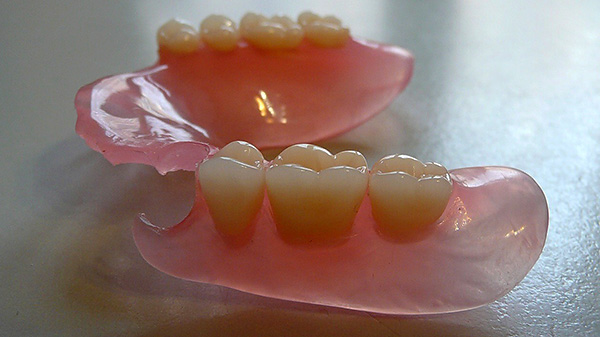
- Byugelnye (from the German "bugel" - arc) - have a power frame in the form of a metal or plastic arc, onto which a base with artificial teeth is welded. In the overwhelming majority of cases, the bump prosthesis in terms of functional characteristics will be much better than the laminar or nylon prosthesis;
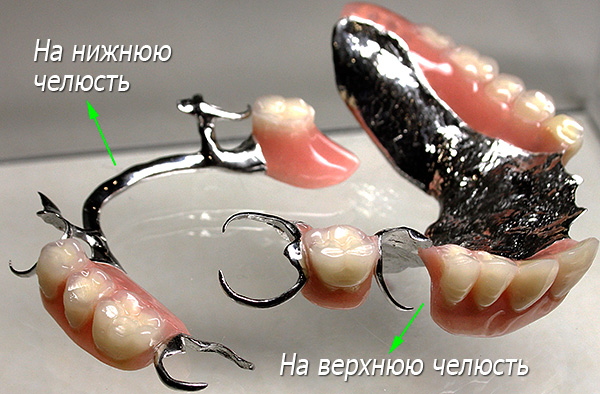
- Immediate dentures (so-called butterfly artificial limbs). Usually used to replace 1-2 teeth. The basis of the butterfly prosthesis can be made of acrylic plastic or nylon and has hooks for fastening over the supporting teeth;

- The so-called dentures of the new generation without the sky (another name - Sandwich). They are a combination of a hard base made of acrylic plastic and elastic polyurethane crowns, which are tensioned onto the supporting teeth. Artificial teeth are set in the plastic base. This is not the best option for prosthetics, as it is inferior in terms of a number of characteristics not only to the clutch prostheses, but also to standard acrylic ones.

Let's take a closer look at the pros and cons of each of these options.
Features of prosthetics with acrylic prostheses
Acrylic prostheses have been used in dentistry for more than 50 years, and during this time they have gained tremendous experience in their use both in a complete removable prosthesis (when there is not a single tooth in the oral cavity) or in part. Now they continue to be installed in huge quantities, especially in Russia - due to the fact that they are cheap, affordable, have a rather long service life and are relatively easy to manufacture.
Accessibility and low cost often become the decisive factor in choosing not only for the patient himself, but also for the orthopedic surgeon with a small production base (for example, in the villages) or insufficient experience with other, more complex and expensive prosthetics.
The photo below shows a partial acrylic prosthesis:
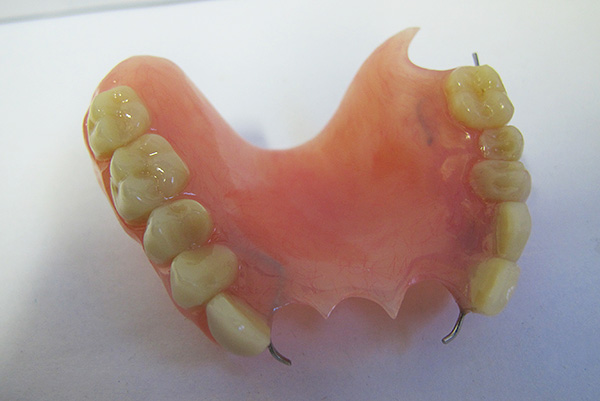
Klammer prosthesis (hooks) are not only metal, but there are also plastic and combined. The materials used strongly influence the cost of the product - for example, a gold or gold / platinum alloy can be used as a metal for clasps (if you are allergic to stainless steel).
On a note
An acrylic prosthesis is retained not only due to the clamping fixation, but also due to adherence to the relief of the mucous membrane - it sticks to the sky and the gums. Therefore, the reliability of its fixation in the oral cavity will significantly depend on the manufacturing accuracy of the prosthesis.
Here are some of the indications for the use of partial acrylic prostheses:
- Unilateral and bilateral terminal defects on the upper or lower jaw (in other words, when any jaw on the right or left has no long chewing teeth). In such a situation, it is not possible to put up a bridge, since there is no one of the supports for the “bridge”;
- When the condition of the remaining teeth does not allow them to be used as a support for the bridge (for example, against the background of periodontitis, the supporting teeth could simply loosen);
- Included defects of the dentition (that is, bounded on both sides by teeth in the mouth), including in the absence of only one tooth;
- The presence in the oral cavity only single teeth in the upper and lower jaw;
- The presence of contraindications to prosthetics on implants.
In other words, the field of application of partial acrylic prostheses is very wide - they can be used in the vast majority of clinical cases.
The photo below shows a partial acrylic prosthesis in the lower jaw:

Significant disadvantages of partial acrylic dentures are:
- The overlap of a large area of hard palate. Due to this, the taste perception is partially reduced (as the taste buds located on the palate are closed), and the diction may also deteriorate. Yes, and just there is an unpleasant feeling of a massive foreign object in the mouth;
- Not the highest aesthetics, especially if the retaining hooks fall into the smile zone;
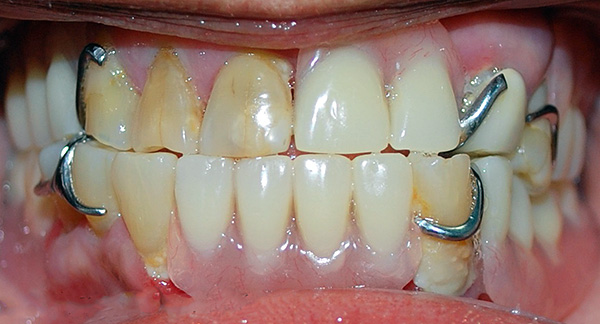
- By virtue of its rigidity, the structure may rub the mucous membrane, causing pain during chewing;
- The reliability of fixing a partial acrylic prosthesis can hardly be called good, especially for the lower jaw (in the upper jaw, it can more or less reliably stick to the palate).As a result, you may need to use a special cream to improve fixation;
- Fragility (a prosthesis may easily crack when it falls);
- Microporosity (with insufficient care, this leads to the appearance of bacterial plaque and a change in the color of the plastic);
- Also, individual intolerance is often observed due to an allergy to plastic monomer, which is actively released into the oral cavity from an acrylic base.
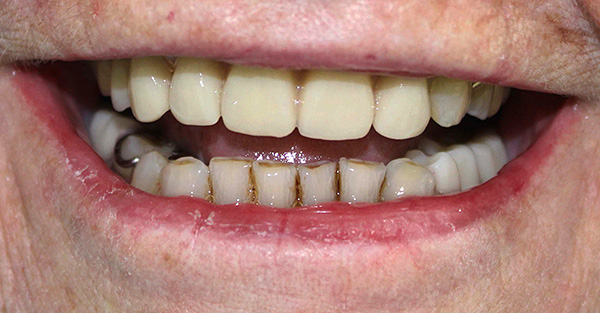
Anyway, with the partial absence of teeth, the use of an acrylic prosthesis is today the most popular budget option for prosthetics.
Advantages and disadvantages of removable dentures made of nylon
Soft nylon prostheses are used both in the complete and partial absence of teeth in the oral cavity. And they are positioned in the advertising of dental clinics as a modern and more convenient alternative to rigid acrylic prostheses. However, about the shortcomings of such products in advertising is silent, and meanwhile, it is useful to know about some nuances in advance.
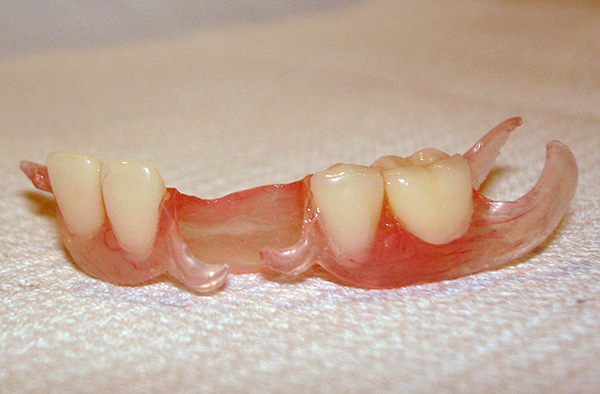
But first, we note the most significant advantages of partial nylon prostheses:
- By virtue of their softness and flexibility, they are more comfortable to wear, adaptation (habituation) goes faster to them;
- Such prostheses, as a rule, are smaller in size and weight than acrylic ones, and therefore less likely to disturb articulation;
- From the point of view of aesthetics, nylon dentures look much better than standard acrylic and byugelny ones, since they are practically not visible from the outside. The hooks of the nylon prostheses have a color similar to that of the gum (unlike the metal hooks of partial acrylic and byugel dentures);
- There is no allergic reaction to nylon - it is a biocompatible material.
However, there are nylon dentures and serious drawbacks, significantly limiting their widespread use in orthopedic practice:
- The main disadvantage is due just to the flexibility of nylon, its softness - the soft design does not evenly distribute the chewing load, as a result of which the bone under the prosthesis quickly atrophies (and with it sags gums, the relief of the prosthetic bed changes, and the design ceases to fit snugly to the mucosa);
- In addition, soft nylon hooks, unlike metal ones, are not able to reliably fix the prosthesis on the remaining teeth;
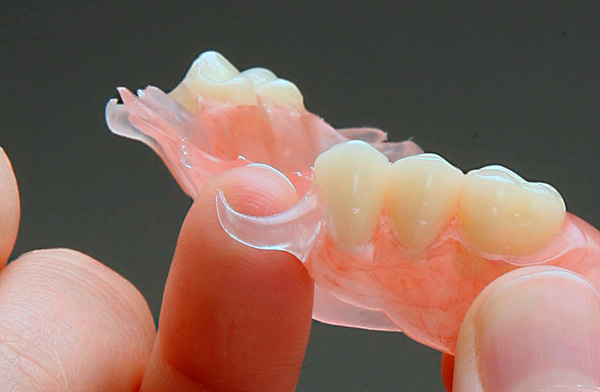
- Due to the softness of the prosthesis, the stability of its suction to the mucous membranes is low - with a slight load (during chewing) under the nylon base, air easily penetrates;
- At the same time, nylon dentures are much higher than acrylic ones (on average, the price ranges from 30,000 to 50,000 rubles).
If you read the reviews of patients about nylon prostheses, it becomes clear that the choice of this option can hardly be considered justified, especially in the absence of a significant number of teeth in the oral cavity (in this case, all the disadvantages will appear even stronger).
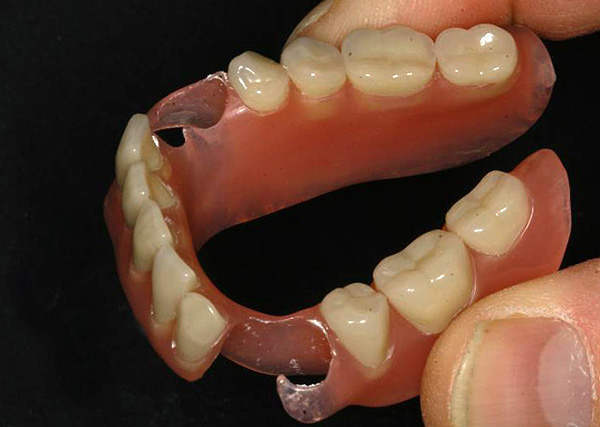
On a note
There are also polypropylene dentures, which are very similar to nylon. However, unlike nylon, polypropylene has more stiffness, therefore products based on it distribute chewing load better, and they have to be corrected less often.
Clasp dentures with partial loss of teeth
It is the byugel dentures in most cases that will be the best option for removable prosthetics with partial loss of teeth.

Here are some of the key advantages of the denture prosthesis:
- Due to the rigidity of the structure, a uniform distribution of the chewing load between the supporting teeth and the soft tissues of the prosthetic bed is achieved (the bone will not atrophy as quickly as under certain sections of nylon prostheses);
- With the locking system of fixation (attachments) high aesthetics are realized - no hooks and other foreign elements will be visible. The same can be achieved by fixing on the so-called telescopic crowns (the methods of fixing the clasp prostheses will be discussed below);
- It is much easier to get used to a removable clasp prosthesis than to a laminar prosthesis, since it takes up less space in the mouth and does not cover the entire palate (which means that the vomiting reflex, prosthetic stomatitis and impaired diction are almost impossible);
- Reliability of fixation of the prosthesis in the mouth is very high. Moreover, the design can be firmly fixed even in difficult cases - when there are end defects of the dentition (in this case, the fastener is used on the micro locks);
- The bugel design not only allows you to regain the lost function (normal chewing) and aesthetics after teeth extraction, but also can have a healing effect when special splint byugel dentures are used that eliminate the mobility of groups of teeth;
- Durable byugelny prosthesis, unlike acrylic, is not so easy to break.
There are several ways of attaching the partial dentures to abutment teeth:
- With the help of a clasp system (hooks). They are usually made of metal, but there are also plastic clasps. Such hooks securely grip the abutment teeth, transferring to them part of the chewing load;
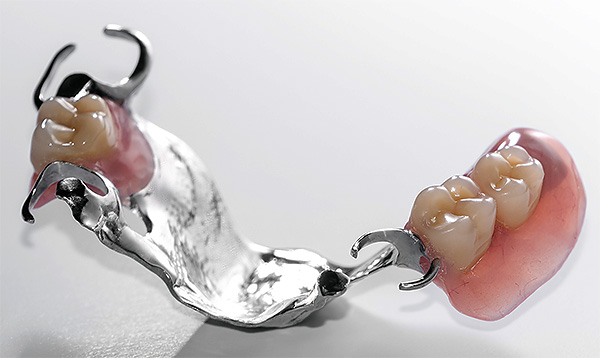
- With the help of attachments (microlock fasteners). Part of the lock is in the prosthesis, and the other part is in a metal-ceramic crown, previously fixed to the abutment tooth. When the prosthesis is put on, the micro lock will snap into place, ensuring reliable retention of the removable structure
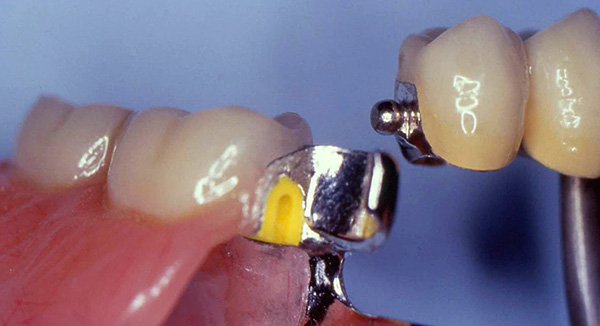
- With the help of telescopic crowns. Metal crowns (fixed) are pre-fixed on the abutment teeth. The cusp denture also contains crowns that are simply put on the crowns of the abutment teeth. This type of fastening is characterized by high aesthetics and reliability.
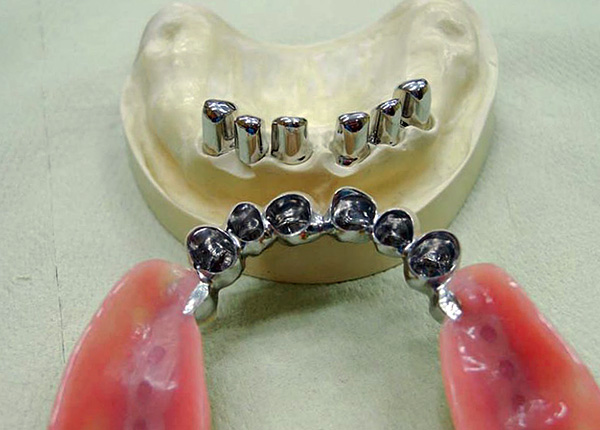
Each of the specified methods of fixing the clasp prostheses has its own advantages and disadvantages. Thus, klamernye byugel is the most simple to manufacture and affordable, but with a smile, metal hooks can be seen, located on the outer side of the teeth, which impairs aesthetics.
As for the castle mounts (attachments) and mounts on telescopic crowns - they are almost invisible from the side, which gives excellent aesthetics and wearing comfort. However, such dentures are difficult to manufacture and, moreover, turning of a decent amount of abutment teeth under the crowns is required.
Despite a number of shortcomings, by-piece dentures can still be considered the best option for prosthetics with partial absence of teeth - both in terms of wearing comfort, functionality and aesthetics, and in terms of price. Yes, a clasp prosthesis will cost more than acrylic, but much cheaper than prosthetics on implants would cost.
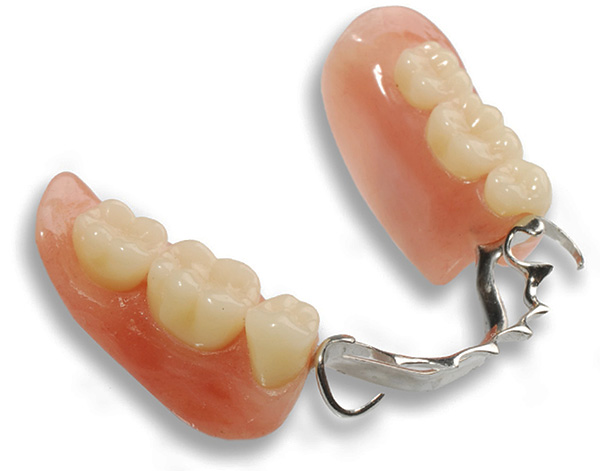
On a note
On average, denture prostheses with fixation on clasps cost about 25-40 thousand rubles. But the prices for constructions with micro-lock fastenings are almost twice as high - a double-sided prosthesis with two attachments can cost around 80-100 thousand rubles.
Removable prosthesis "butterfly" for the immediate replacement of lost teeth
Imagine a situation that you have removed 1 or 2 teeth. While the hole is healing and a non-removable bridge is being made (or an implant is to be installed in the future), it will take some time to walk with a hole in the dentition, which many patients would like to avoid.
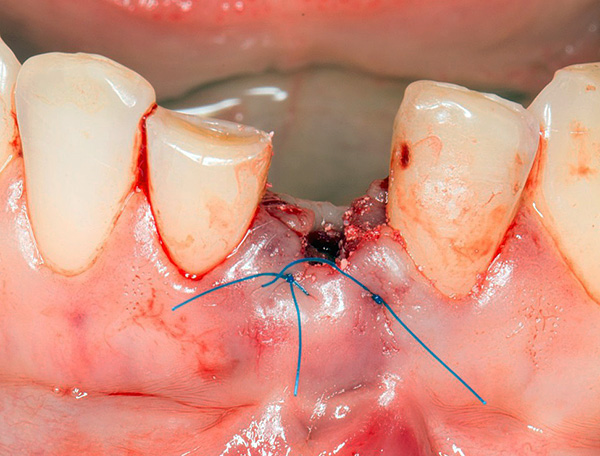
It is for such cases that the best option would be to use a removable immediate denture - otherwise, a butterfly prosthesis (lat. "Immediatus" means "direct", that is, it is about the possibility of replacing a tooth with a prosthesis immediately after removal). This prosthesis was called the butterfly because of the external similarity of its base and hooks with butterfly wings.
The photographs below show removable prosthetic butterflies:
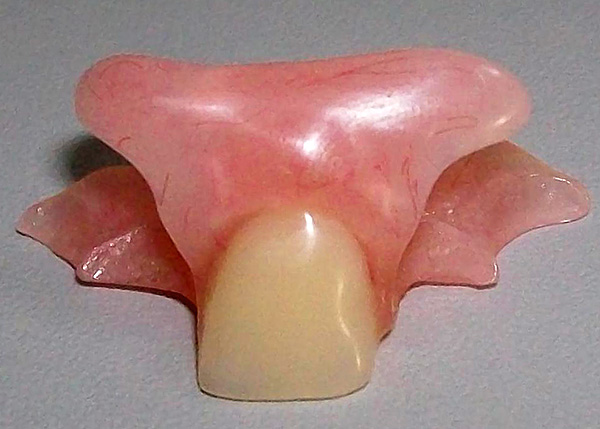
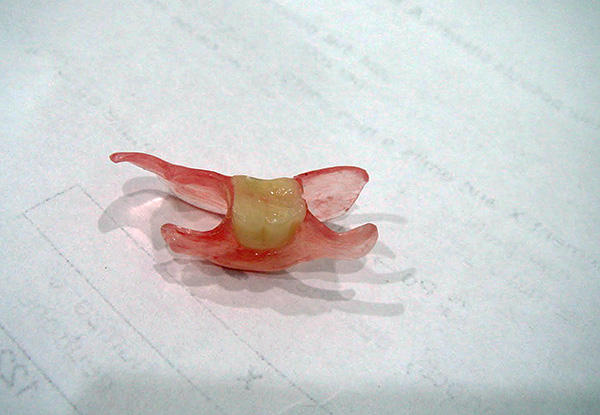
A removable prosthetic butterfly can be made on both the upper and lower jaw. It is retained mainly due to the girth of the hooks of the adjacent teeth. The basis and hooks can be made of acrylic plastic or nylon (in the latter case, a particularly good aesthetics is achieved).
On a note
Generally speaking, an immediate prosthesis is a temporary structure for the rehabilitation period before the manufacture of fixed prostheses (for example, bridges). But, as practice shows, some patients use the prosthesis-bow tie all the time, not wanting to grind their teeth under the crown of a bridge-like prosthesis and having no funds or implantation.
In general, it can be said that the butterfly prostheses allow not only restoring aesthetics immediately after tooth extraction (or teeth), but also improve chewing functions,allowing you to evenly distribute the load and without overloading the teeth, limiting the "gap".
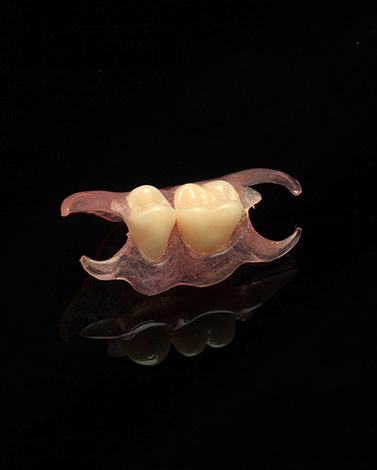
It is interesting
The use of removable dentures with partial loss of teeth is not only aesthetic and functional value for the patient, but with the right approach, it preserves the health of the entire dentition. This is especially true for the prevention of diseases of the temporomandibular joint, periodontal disease (gum disease) near the remaining teeth, as well as the preservation of a normal bite.
About removable dentures of a new generation without sky
So-called removable dentures of the new generation without the sky (sandwiches) really have an important advantage over standard laminar dentures, namely, they do not overlap the sky (therefore, they do not reduce taste sensitivity, do not cause gag reflex, do not impair articulation, do not create the sensation of a massive foreign object mouth, etc.)

Recall that in sandwiches a rigid acrylic part with artificial teeth is combined with elastic polyurethane crowns, which are stretched onto the supporting teeth.
Despite the positioning in advertising as a new generation of designs, sandwiches have serious disadvantages:
- Polyurethane crowns, tightened on the abutment teeth, may look too massive (the thickness of the walls of such crowns can reach 1.5 mm);
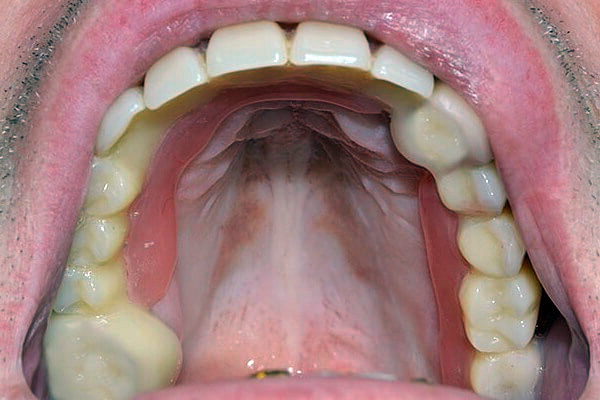
- After fixation, the stability of the removable structure in the mouth will be much lower than that of the clutch prosthesis (the elastic polyurethane part will bend when chewing);
- A small area of the base, although it contributes to the convenience of wearing a prosthesis (less interferes with the mouth), however, causes a strong pressure on the prosthetic bed. In turn, this can lead to pain when chewing food.
Therefore, despite the fact that the design of prostheses is quite original, in general, they are much inferior to the clasp by functional and aesthetic characteristics.
On a note
If we talk about the convenience of wearing due to the lack of overlap of the sky, then it is worth noting that, due to the hard arch, removable byuhelny prostheses on the upper jaw may also have minimal overlap of the sky. In the case of using denture prostheses for the lower jaw, the sublingual space is also overlapped to a minimum.
Conditionally removable dentures on intracanal implants
In the absence of a significant number of teeth in the oral cavity and especially the not very good condition of the crown part of the remaining teeth, the use of a conditionally removable prosthesis with installation on so-called intracanal implants can be a good option for prosthetics.
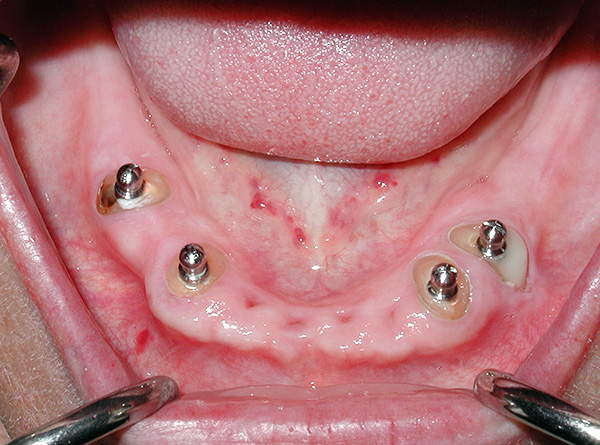
To install this design, you must have at least 2 (and preferably 4) teeth on one jaw (upper or lower). The essence of the method is as follows:
- The crown parts of the remaining teeth are cut down to the level of the gum;
- A titanium implant with a spherical abutment is screwed into the root canal of each tooth;
- A prosthesis is being made that has recesses on the inside with special locks for a spherical abutment of implants.
As a result, the removable denture is attached very securely, it is not visible from the outside, even without hard food and discomfort, it is possible to chew on it even hard food, it is comfortable to wear it. At the same time, the preservation of the roots of the teeth allows minimizing atrophic processes in the jaw bone.

The disadvantages of this type of prosthetics:
- high price;
- low prevalence of this service in clinics;
- it is far from suitable for every clinical situation (the patient does not always have the necessary number of teeth, and even if there is, then the root condition of the roots is not always satisfactory).
Rules for the care of removable dentures and a few words about their repair
After the denture is handed over to the patient, the orthopedic dentist explains how to properly care for it, so that the construction lasts as long as possible.
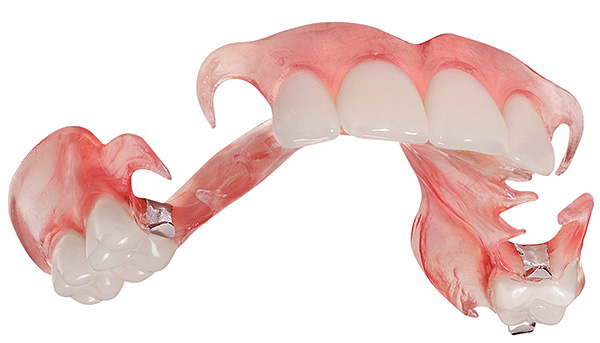
General recommendations in this case imply the following:
- Daily clean the denture with a toothbrush with a non-abrasive paste;
- After eating, rinse with water;
- Use special disinfectant solutions;
- Store dentures in boiled water or in a special solution;
- If you feel pain during the operation of the prosthesis, it is important to urgently visit the dentist to find the cause of the pain.
It is useful to use special tools for the hygiene of removable dentures:
- Toothbrushes for dentures. Sometimes these brushes have bilateral placement of the bristles - for the outer and inner surfaces of the prosthesis;
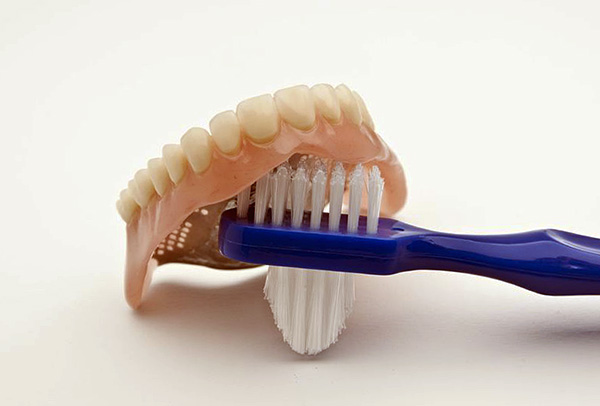
- Tablets for cleaning dentures (Corega, effervescent tablets Dentipur, President, ROCS, Protefix, etc.). After dissolving the tablet, a solution is obtained, where the removable denture sinks - this eliminates plaque and provides an antibacterial effect.
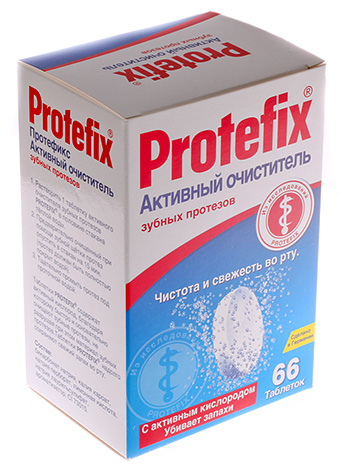
It often happens that after a few years of wearing a prosthesis, the prosthetic bed (mucous membrane) sags and the structure becomes inconvenient to use - for example, the plate construction can stick to the sky poorly, food can get under it, it starts to rub the gums, etc. Therefore, after receiving the prosthesis, it is desirable to apply for routine inspections at least once every six months for the correction and professional hygiene of the structure.
It is better to entrust the repair (repair) of dental prostheses to specialists, as an attempt to restore the structure on its own can only accelerate the process of jaw bone atrophy due to the uneven load transferred by the illiterately repaired prosthesis to the prosthetic bed.
Repair options can be very different: gluing parts of a cracked laminar denture, repair of a klammer, installing a fallen out artificial tooth, relocation, so that the design fits tightly to the mucous membrane, etc.
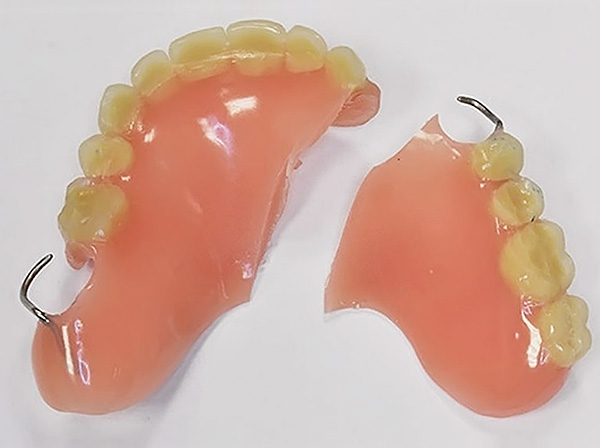
On a note
The big disadvantage of a removable nylon prosthesis is the impossibility of its relocation. Meanwhile, relocation is extremely important, as over the years, bone tissue atrophy occurs under the prosthesis and the shape of the alveolar process changes, which disrupts normal chewing and aesthetics. If it is not a problem to relocate acrylic laminar prostheses, then it is almost impossible to relocate prostheses made of nylon and polypropylene - it is easier to buy a new product.
How much is the installation of a partial denture today?
Prices for partial removable prosthetics depend on many factors:
- From the level of the clinic (economy, premium, business class);
- Whether prosthetics is made in Moscow or anywhere in the region (prices are almost always higher in Moscow);
- From the choice of design and materials used.

With partial absence of teeth, prosthetics with laminated acrylic prostheses with metal clasps is considered the most budget-friendly (it is not always aesthetically obtained, since metal hooks are clearly visible in the smile zone; other shortcomings of such structures have already been mentioned above).
The table below shows the approximate prices for partial dentures in Moscow in mid-2017:
| Type of prosthesis | Price, thousand rubles |
| Partial removable acrylic | 15-20 |
| Partial removable nylon | 25-50 |
| Clasp on clasps | 30-50 |
| Byugelny splinting | 40-50 |
| Byugelny on locks (attachments) | 80-100 |
| Prosthetic butterfly | 8-10 |
In conclusion, it is worth noting that even in the absence of a small number of teeth in the oral cavity, you should not over-tighten with the prosthesis. Even the choice of the most inexpensive prosthesis will be much better for the entire dental system than if you do nothing and walk with holes in your mouth.
In this case, you should not go on about advertising and immediately focus on the fashionable now nylon prostheses. If you do not take into account the implantation (due to its high cost), then the most practical and perfect version of the prosthesis will be the use of clasp prosthesis.
Be healthy!
What are removable dentures and what is important to know about their properties
Useful video: how to fully live with removable dentures ...


